











 Ivory comparative slide rule signed Buss Maker 48 Hatton Garden London. Thomas Odempsey
Buss and his successors were at various Hatton Garden addresses from 1865-1911.
I also have a boxwood one signed 33 Hatton Garden in a set of spile rods that can
be seen in www.mathsinstruments.me.uk/page59.html.
Ivory comparative slide rule signed Buss Maker 48 Hatton Garden London. Thomas Odempsey
Buss and his successors were at various Hatton Garden addresses from 1865-1911.
I also have a boxwood one signed 33 Hatton Garden in a set of spile rods that can
be seen in www.mathsinstruments.me.uk/page59.html.

The rules on this page originally comprised two main categories. The first was alcohol rules used for calculating the quantity in a cask and/or the excise duty payable. The second was folding rules with a slide for ancillary calculations such as the carpenter’s rule (Coggeshall rule) and the Routledge engineer’s rule. More recently I have added a First World War artillery slide rule and a Thomlinson’s Equivalent Paper Slide.

Alcohol slide rule by J Long, London, made of boxwood and probably dating from the early twentieth century. Length 8¾ inches. The rule is almost certainly from a box containing a Sikes hydrometer, which it would have been used in conjunction with (see Miscellaneous instruments pages). It is a “Proof” slide rule for the calculation of percentage proof and is one of two types of slide rule for use with the Sikes hydrometer.



 Alcohol slide rule by Joseph Long, 43 East Cheap, London. Long’s business (posthumous) was at this address from 1885 to 1936. This appears to be primarily a gauging rule for determining the content of casks whether standing or lying and also functions as a comparative rule.
Alcohol slide rule by Joseph Long, 43 East Cheap, London. Long’s business (posthumous) was at this address from 1885 to 1936. This appears to be primarily a gauging rule for determining the content of casks whether standing or lying and also functions as a comparative rule.



Farrow & Jackson Ltd, London, spirit slide rule, probably ca.1900. Nine inches long, boxwood and brass.. This is the other type of slide rule found with Sikes hydrometers and is a “Comparative” slide rule.The upper face is used for costing and the lower face for reducing. Ref: Pierre Vander Meulen, Sikes’s Hydrometer and Related Slide Rules, Journal of the Oughtred Society Vol. 10 No. 1 Spring 2001 pp 30-34. I have another comparative slide rule by Sanders & Sons.

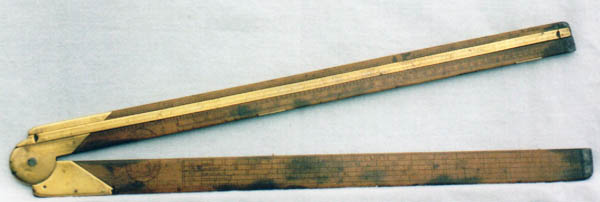
Carpenter’s slide rule by Bradburn, made of Boxwood and brass with steel end caps. George & Thomas Bradburn (18 Alcester Street, Birmingham) were rule makers working 1841-52. A two foot, two-fold rule.

Carpenter’s slide rule by J Rabone & Sons, Birmingham. A boxwood and brass, three foot, four-fold rule, probably dating from the early twentieth century.

Routledge engineer’s slide rule by S A Smith, made of boxwood and brass with steel end caps. It has been repaired, many years ago, with riveted on nickel silver plates. Samuel Albert Smith (Coventry Road, Birmingham) was working from 1850 to 1862.






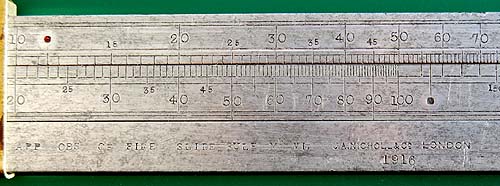
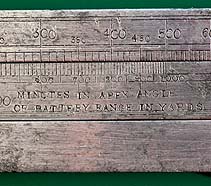
Apparatus, Observation of Fire Slide Rule Mk VI made by J A Nicholl & Co of London in 1916. The rule is made of aluminium with brass end pieces. The body of the rule is 16” long. When purchased it was minus cursor and a replica of the brass cursor has been made using the scans of a similar rule in Herman van Herwijnen’s archive on Rod Lovett’s website as a reference.
Thomlinson’s Equivalent Paper Slide. This mahogany and boxwood slide rule is 585 mm long and has two slides. The scales are lettered A to E from top to bottom. Scales A & B in conjunction with C enable the area of a sheet of paper to be calculated. Scales D and E are concerned with calculating the weight of a ream of paper using either standard sizes given on scale E or the size calculated using scales A to C. Reams of 480, 500 and 516 sheets are catered for. J Thomlinson Lm, Publishers, Partick, Glasgow.
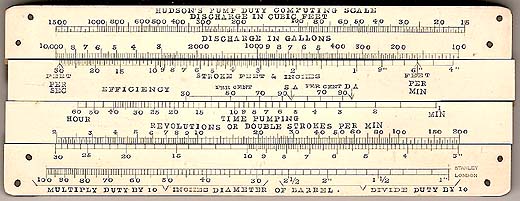
Hudson’s Pump Duty Computing Scale, made by W F Stanley, London, late 19th or early 20th century. A celluloid faced wooden open frame slide rule with nickel silver end braces and two slides. It has a Morocco leather covered, card slip case. The scales are: discharge in cubic feet, discharge in gallons, stroke feet & inches, efficiency (single acting & double acting), time pumping, revolutions or double strokes per minute, inches diameter of barrel. The last scale is in three sections over two lines. If the lower line is used then the result has to be either multiplied or divided by ten. J G Hudson C.E. also invented a horsepower computing rule (for steam engines - see below), a shaft & girder slide rule, and a photographic exposure calculator, all of which were also made by Stanley. These scales were all made in a variety of materials including boxwood, card, opaque celluloid, and ivory.



Mannheim type slide rule by A Franks of Manchester (presumably the retailer). It appears to be boxwood with a folded celluloid cursor. It has pasted on tables on the reverse and a black card case. Scales are: A(B,C)D.


J H Steward Ltd, 406 Strand London ‘The MT Slide Rule’. Celluloid covered pearwood. The upper face has map scales around the edge (1/100,000 metre; 1/100,000 miles; 1/4” = 1 mile metre; 1/4” = 1 mile) and the slide converts miles to km. The slide rule scales on the other face are: No Veh{V.P.M.,M.P.H}T.P.P. These are number of vehicles in column, number of vehicles per mile, speed of column in miles per hour and time taken to pass a position.


Another J H Steward MT slide rule made of celluloid and pearwood. The map scales on the upper face are differently arranged (1/4” = 1 mile; 1” = 1 mile; 1” = 1 mile metre; yards 1” = 1 mile. The calculating scales are also slightly different (highest mph is 30 not 40; max no of vehicles is 160 not 240) suggesting that this is the earlier version.


Six inch ivory and nickel-silver ‘comparative; slide rule signed J Long, London. More alcohol slide rules including ones by J Long can be seen near the top of this page. This rule probably came from a small size Sikes hydrometer set. A ‘Gentleman’s set possibly.


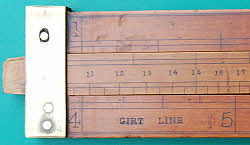
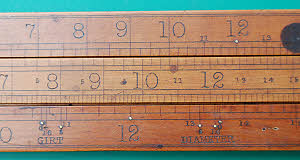
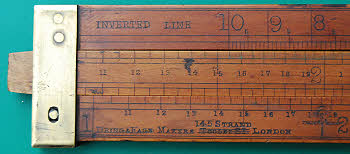
An unusual 24” long boxwood and brass slide rule by Dring & Fage, 145 Strand, London dating from 1883-1902. It is double sided. On one side the scales are those associated with a Coggeshall (timber) slide rule being three double radius log scales and a single radius girt line scale. On the other face there are three double radius log scales again and a double
radius “inverted line” scale. On both edges are 0 - 24” x 1/4” linear scales (rulers). Returning to the first side and looking at the girt line scale there are two sets of brass pins, one either side of “12” (which also has a brass pin as does 12 on the top scale). These two sets of three pins (one is missing on the left hand side) are labelled “Girt” and “Diameter” respectively and there are also numbers associated with these pins, namely 0, 16, 8 and 8, 16, 0 respectively from left to right. These pins indicate gauge points associated with the rounding of timber and calculating its volume. Basically 0 indicates round, 8 is eight sided and 16 is 16 sided. For instance looking at the right hand 0 the value is 13.54, the ratio of the diameter for circular timber used to calculate the volume using the Girt line scale and the adjacent double radius log scale. The pins on the right relate to calculating the volume from diameter and length and those on the left from girth and length. The numbers 12 are marked with pins because they are also frequently used in timber calculations (there are 12 inches in a foot).


Farmar’s Profit Calculating Rule - A business slide rule for pricing, buying and selling. It is constructed of wood faced with paper scales covered with clear celluloid. The end caps are black plastic. The roller has price scales from 1d to £20 and the slide has profit on turnover and discount, and profit on cost scales in percentages. The instructions are on the reverse of the body. It has a paper covered card box.

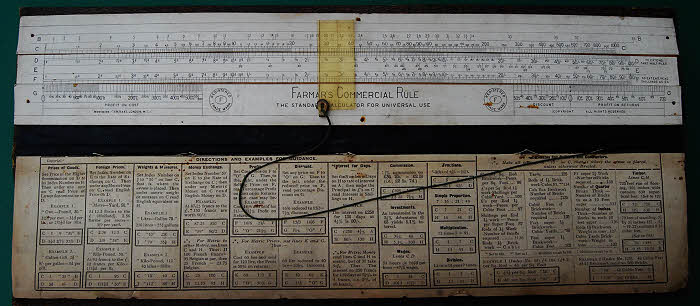
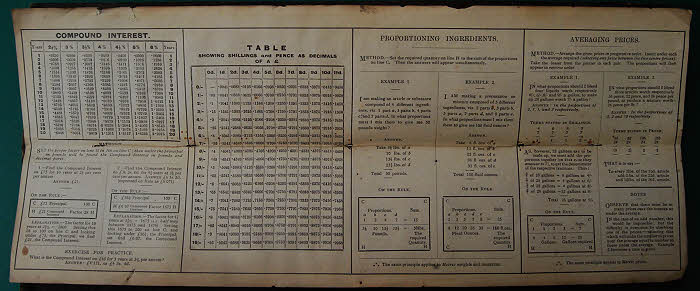
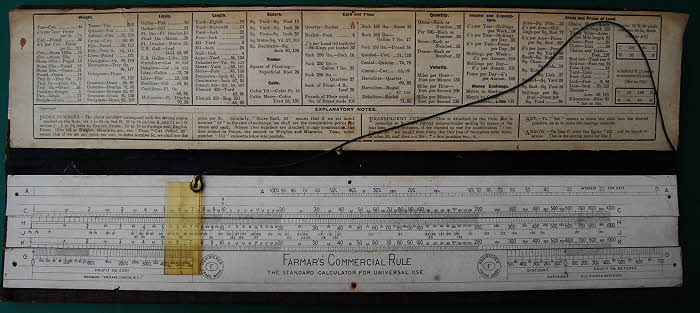
Farmar’s Commercial Rule - The Universal Ready Reckoner 18” length overall and constructed of wood, card and paper including two slide rules, two leaves of instructions and tables, and a celluloid cursor on a cord. The upper slide rule has two index lines (B & E) the numbers on which are effectively gauge points used for converting amounts from one unit to another (e.g metres to yards) The appropriate number can be found from the tables on the last page of the centre leaves. Lines C and D are used for finding the price of multiple items knowing the price of one and for converting the price from one denomination to another (e.g. cwt to tons). Lines F and G are used for calculating discounts and profit. The lower slide rule also has an index line J. Using lines C, H & A interest can be calculated. Lines K & G are for calculating discounts and profit with decimal currencies. I have only summarised some of the calculations that can be performed; there are many more. Date probably ca.1920
Carpenter’s slide rule signed ‘J Aston Maker Warranted Best Box’, made of boxwood and brass with steel end caps. John Aston was one of a number of rule makers named Aston working in Birmingham in the 19th century. A two foot two-fold rule. I originally thought it was by Isaac Aston of London.


Another, different, carpenter’s slide rule by John Aston, Birmingham (working 1854-82). Two foot two fold boxwood slide rule with brass slide and outer hinge plates. Steel end caps and inner hinge plate. Double radius log scales on rule and slider, girt line scale, ¼, 3/8, ½, 5/8, ¾, inch plain scales, twenty four inch ruler on reverse plus 12” on reverse of slide, E & M scales. The latter (edge and middle) scales were used to set out an octagon when rounding timber for masts, etc.


John Rabone and Son Warrant Boxwood, Vulcan hinged, carpenter’s two foot two fold slide rule dating from 1869-77. Probably a no. 2421. The registered design diamond for 13 Oct 1869 refers to the Vulcan hinge . Besides the ruler scales it has on the upper front the usual A{B,C}Girt Line scales, on the lower front 5/8 and inch draughtsman’s scales, and on the reveres 8 Square and Line scales. There is a decimal foot ruler on the upper edge and the lower one is bevilled (Spelling in the 1878 John Rabone & Sons catalogue).


John Rabone & Sons boxwood carpenter’s slide rule. This one has load tables on the lower front side. As well as the ruler on the back there are 8 Square and Line scales (elsewhere called Edge and Middle). There is a protractor hinge. Ca. 1900.



Wm Marples & Sons combined Coggeshall and architects rule in ivory and nickel silver. On the front face the first leg has the usual Coggeshall scales and slide. The opposite leg has price per load tables. The other two legs have a series of scales 1/6, 1/5, 1/3, 1/2, 5/8, 7/8, 1 1/4, 1 1/2. The inner face has inch scales to 24” by 1/16, 1/8, 1/12, 1/10. The bevelled inner edges have 1/16, 1/8, 1/4, 1/2, in, 3/16, 3/8 and ¾ scales and there is a decimal feet scale on the outer edge.


Farmar’s Rule, The Standard Slide Rule for the Entire Wine & Spirit Trade (Desk Size). Farmar held a number of patents for alcohol slide rules. This twenty inch long duplex slide rule, mahogany faced with celluloid, with brass end bridges carried out a comprehensive range of functions including reducing, gauging, and calculating profit on sales. The cursor is celluloid screwed to wood. Early twentieth century.


Another similar alcohol slide rule by Joseph Long, 43 East Cheap, London, but this one is ivory and nickel silver. The scales are A{B}Segt St{N}Seg Ly//D{C}E{Proof}F. There are also three gauging scales on the upper edge for different shapes of cask, including SPED (spheroid) and 2nd Variety. The scales are the same as on the boxwood and brass version. It dates from the same period.


Farmar’s Wine & Spirit Merchant’s Rule, The Standard for the Entire Trade. Boxwood and brass slide rule, 23 inches long with 24 inch slide. Basically the same scales as the rule above, but lower prices because of the earlier date. Extra ‘Altimeter’ scale on one edge. ‘Size 1 (1610)’ on the other.. Early twentieth century.

Dring & Fage, 145 Strand, London, alcohol slide rule made for the Inland Revenue. This 24 inch rule is single sided with just four scales: A{B,B}Seg Ly. Boxwood with brass end bands. Made between 1883 & 1902.

Alcohol slide rule by Cock, London with four slides, two each side, made of boxwood and dating from about 1830 to 1840. Length 9 inches. The rule came from Kemp Town Brewery, Brighton when the brewery closed after take-over by Charringtons.


Gauger’s slide rule, open frame type with two slides, approximately nine inches long. The scales on the front and back faces are the same as on the Cock slide rule above but the four sets are arranged in a different order. There are scales on the edges (not shown). On one edge there are scales for spheroid and 2nd variety (not named) and on the other edge is a single radius log scale and an adjacent similar scale displaced by 1.6. The scales on the faces are: A{B,B}SL./A{C,C}MD//D¹{B,B}D²/A{C,C}SS. SL = Segment Lying, SS = Segment Standing, MD = Malt Depth. Scale. D¹ and D² are the two halves of an 18 inch long log scale. The first half is not labelled and the second half is labelled ‘D’. Because it has IMB and IMG gauge points it must date after 1824 and it must be earlier than 1880 as it has the malt depth scale. I would date it about 1850-1860. It is boxwood and brass with brass pins inset at the gauge points.


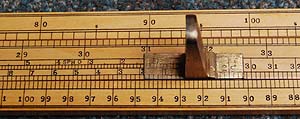
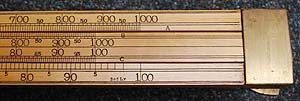
This Head Rod is actually ca.1968 but I have placed it here to be with the other alcohol slide rules. It is 50 inches long and is actually a prototype metric version with the measuring scale reading to 124 cm. It is both a measuring instrument (to measure the head diameter (the projecting brass feet enable it to measure inside the chimes) and a slide rule to calculate the volume inside the cask, both full and part full. The left enlargement shows the scale marked SPH’D (spheroid); the adjacent unmarked scale will be ‘2nd variety’ being different shapes of cask. The right enlargement shows the ullaging scales on the other side of the rule marked A{B,C}Seg Ly. Made by Dring & Fage, overtaken by the digital age, only a few prototypes made.





Gauger’s slide rule of the Everard type, probably from the 2nd half of the 18th century and certainly pre-1824 as it has the gauge points for the old wine gallon and ale gallon. The undersides of the four slides, shown in the bottom picture are also graduated, two being for various shapes of cask (variety 2, 3, spheroid, cone).




An Everard type gauger’s rule by Cock, London, This one has imperial gauge points and dates to 1830-40. The undersides of one slide has scales for different barrel shapes. The others are plain. Presumably a little earlier than the rule below by the same maker.


This head rod, signed Dring & Fage London Maker to the Customs & Excise, is the usual 44 inch long one for Imperial measurements.



I & D Smallwood Coggeshall rule in boxwood and brass. The front face again has the usual Coggeshall scales on the upper leg and price per load tables on the lower. The other two legs have a series of plain scales. The inner face has inch scales to 24” by 1/16 and 1/10. There is a decimal feet scale on the outer edge. There is a six inch scale on the reverse of the slide.



A six inch four fold Coggeshall rule by Edward Preston & Sons. The top left hand pictures shows the A{B,C}Girt Line scales and below them 1/2 and 1/4 scales and inches x 1/16. The top right hand picture shows inch x 1/8 scales at the edge with price per load tables in the centre for 50 cu ft loads. The inner faces have inch x 1/8, inch x 1/12 and inch x 1/10 scales. On the outer edge of the rule is a decimal feet scale.


Routledge engineer’s slide rule signed Richards Optician 70 New Street Brmingham. Unusually it has brass edge strips alomg both inside and outside edges. On the upper face the upper half is a Soho configuration slide rule with three double radius log scales (1-10-100) and one single radius (1-10). The lower face is a comprehensive table of gauge points. On the lower face is a 24 inch ruler and four drawing scales (1/4, 1/2, 3/4 and Full size). This is a fairly standard Routledge configuration.


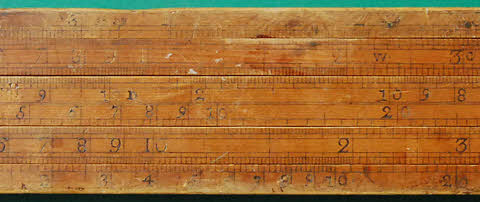
An unusual alcohol slide rule that has a solid body with two slides set into the top face. As it has gauge points for wine and ale gallons and other gauge points that are pre-imperial it must date from before 1824 and is probably ca.1800. It has an unusual pair of scales on the middle part of the stator.
Starting from the left hand edge of the upper stator scale is a single radius log scale from 3.2 to 10 that ends near the middle of the rule. Starting from the right hand edge is an inverted single radius scale from 2 to 2 that ends adjacent to the end of the other scale. The rear face of the rule has an inch x tenths scale and three scales marked spheroid, 2nd variety and 3rd variety to cater for the different shapes of cask.

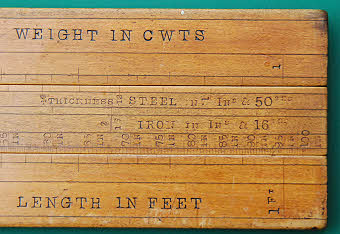
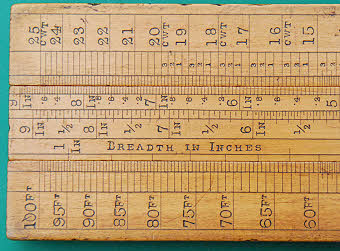
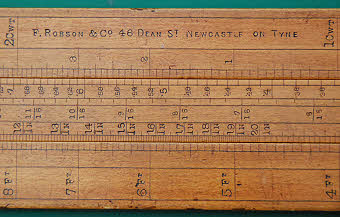
F Robson & Co, 45 Dean St, Newcastle on Tyne boxwood slide rule, 24.5” LOA for finding the weight of steel or iron bars and plates. Scales are Length in feet from 1 ft to 100 ft; breadth in inches from 1 in to 100 in; thickness, iron in inches & 16ths from 2/16 to 9 in, steel in inches & 50ths from 12/50 to 9 in; weight in cwts from one quarter to 25 cwt.
Strangely the quarters are divided into twelve where space permits even though a quarter is 28 pounds. The length scale feet are divided into 12ths (i.e inches) up to 20ft but longer lengths are divided into 10ths (and fractions of tenths where space permits). Probably late 19th century.

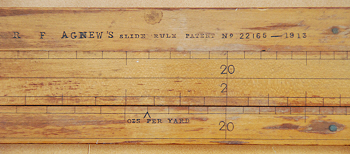
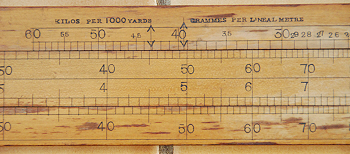
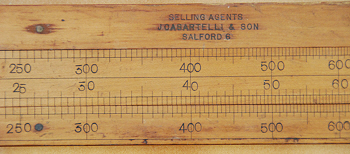
R F Agnew’s slide rule patent no. 22165 - 1913 for calculating the weight of cloth
or other materials. Selling agents J Casartelli & Son, Salford 8


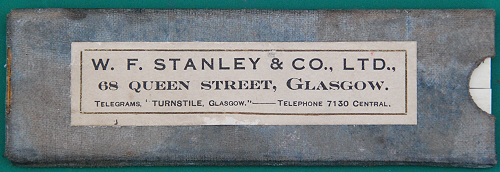


Hudson’s Horse Power Computing Scale for steam engines made by W F Stanley. On the
front face the upper scale is for Indicated Horse Power. The scale on the first slide
is for Revolutions and also Piston Speed, the adjacent scale on the second slide
is for Stroke, the next scale is for Mean Pressure and the bottom scale is for Cylinder
Diameter. The scales on the reverse are for correcting the Mean Pressure for percentage
of stroke at which steam is cut off, and back pressure & corners. The instructions
for its use are given in my paper on Hudson’s computing scales.
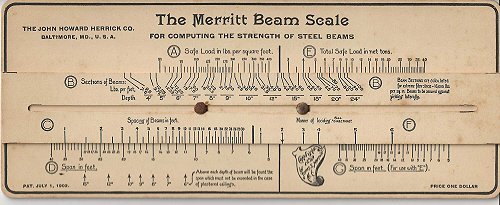
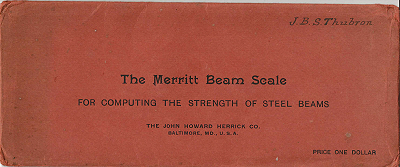
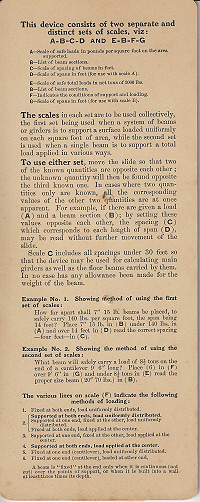
The Merritt Beam Scale for Computing the Strength of Steel Beams was invented by
W James S Merritt ME, copyright 1899 and patented July 1, 1902. It was produced by
the John Howard Herrick Co in Baltimore, Md, USA. It is actually two separate calculators
although scale B is common to both. The left hand side is for a number of beams supporting
a floor or similar with uniformly distributed load. The right hand side is for a
single beam and caters for different types of loading (point or uniformly distributed),
built-in or simply supported ends, and beams supported at both ends or cantilevers.
Instructions and examples are given on the reverse.



![]() Ivory comparative slide rule signed Buss Maker 48 Hatton Garden London. Thomas Odempsey
Buss and his successors were at various Hatton Garden addresses from 1865-
Ivory comparative slide rule signed Buss Maker 48 Hatton Garden London. Thomas Odempsey
Buss and his successors were at various Hatton Garden addresses from 1865-































































































